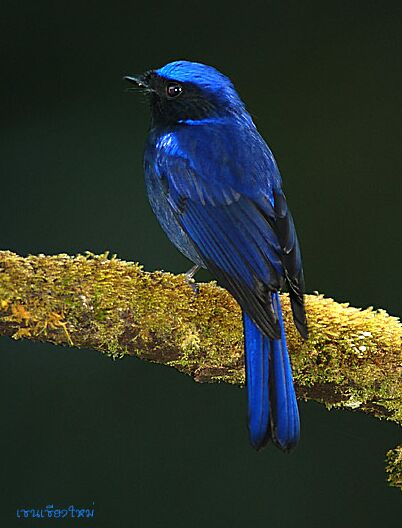
Niltava grandis
SUBFAMILY
Muscicapinae
TAXONOMY
Niltava grandis Blyth, 1842.
OTHER COMMON NAMES
English: Great Niltava; French: Grand gobemouche; German:
Kobaltniltava; Spanish: Niltava grande.
PHYSICAL CHARACTERISTICS
The body length is about 8 in (20 cm). The sexes are colored
differently. The male has a dark-blue back and a brilliant-blue
top of the head, a black mask through the eyes, a black throat,
and a shining orange-rufous belly. The female is rather uniformly
olive-brown with a lighter belly, and the juvenile is
light-brown with whitish spots.
DISTRIBUTION
A species of the Himalayan region of Nepal, Bhutan, and western
India, and extending through the mountains of Myanmar,
Thailand, Cambodia, and southwest China and Southeast Asia,
including the Malay Peninsula and Sumatra.
HABITAT
Occurs in humid, dense, broad-leafed forest, often near a
stream. Mostly breeds at altitudes of 5,000–9,350 ft
(1,525–2,850 m).
BEHAVIOR
A nonmigratory species, but undertakes seasonal movements
between high- and low-elevation habitats. Pairs of breeding
birds defend a territory. Not highly active, and often sits on
perch for rather long periods without feeding. The song is a
series of three or four simple, rising whistles.
FEEDING ECOLOGY AND DIET
Catches flying insects in the middle part of the canopy by an
aerial sally from a perch. Often returns to the same perch. Also
eats small fruits.
REPRODUCTIVE BIOLOGY
Nests in forest. Builds a cup-shaped nest of mosses and other
fibers in a mossy area among rocks on the ground, against a
tree-trunk, or in a shallow cavity in a rotten stump.
CONSERVATION STATUS
A rare, endemic species of the western Himalayas. However, it
may be locally abundant and is not threatened according to
IUCN criteria. Nevertheless, its forest habitat is rapidly being
lost and the species should be closely monitored.
SIGNIFICANCE TO HUMANS
None known, except for the economic benefits of birdwatching.
Photo Gallery of - Large niltava




 Animalia Life
Animalia Life